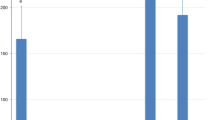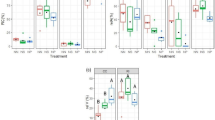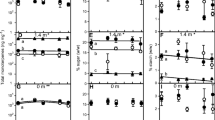Abstract
Tall fescue (Festuca arundinacea Schreb.) is a C-3 perennial grass noted for its persistence in harsh environments. Tall fescue persistence is enhanced byAcremonium coenophialum, a mutualistic fungal endophyte that increases resistance to drought, pathogens, and insects. This research was conducted to identify and elicit biochemical mechanism(s) that could account for tall fescue persistence. In initial studies, two cultivars known to differ in persistence were analyzed for chitinase, an antifungal hydrolase associated with disease resistance in other plants.Acremonium-infected Kentucky 31 (KY31), a persistent cultivar, and Johnstone, a nonpersistent cultivar, were inoculated with the parasitic nematode,Meloidogyne marylandi, grown for 50 days, and analyzed at 10-day intervals. Chitinase fluctuated throughout the 50-day period of seedling development, and activity was highest in the persistentAcremonium-infected KY31. In addition, chitinase was elicited by parasiticM. marylandi and expressed systemically. Subsequent studies were conducted to determine whether or not mutualisticAcremonium could increase chitinase activity. Genetically identical KY31, with and withoutAcremonium, were grown for 25 days and analyzed for chitinase at 5-day intervals. After 20 days,Acremonium-infected KY31 expressed more chitinase thanAcremonium-free KY31. We concluded that chitinase is related to tall fescue persistence; it was highest in the most persistent cultivar, increased under pathogen attack, and increased in the presence ofAcremonium, a symbiont known to enhance disease resistance.
Similar content being viewed by others
References
Bacon, C.W., andSiegel, M.R. 1988. Endophyte parasitism of tall fescue.J. Prod. Agr. 1:45–55.
Bacon, C.W., Porter, J.K., Robbins, J.D., andLuttrell, E.S. 1977.Epichlöe typhina from toxic tall fescue grasses.Appl. Environ. Microbiol. 34:576–581.
Boller, T. 1985. Induction of hydrolases as a defense reaction against pathogens, pp. 247–262,in J.L. Key and T. Kosuge (eds.). Cellular and Molecular Biology of Plant Stress. Alan R. Liss, New York.
Boller, T., Gehri, A., Mauch, F., andVögeli, U. 1983. Chitinase in bean leaves: Induction by ethylene, purification, and possible function.Planta 157:22–31.
Bradford, M.M. 1976. A rapid and sensitive method for the quantitation of microgram quantities of protein utilizing the principle of protein-dye binding.Anal. Biochem. 72:248–254.
Buckner, R.C., Boling, J.A., Burrus, P.B., Bush, L.P., andHemken, R.A. 1983.Crop Sci. 23:399–400.
Burns, J.C., andChamblee, D.S. 1979. Adaptation, pp. 9–30,in R.C. Buckner and L.P. Bush (eds.). Registration of Johnstone Tall Fescue. American Society of Agronomy, Madison, WI.
Byrd, D.W., Kirkpatrick, T., andBarker, K.R. 1983. An improved technique for clearing and staining plant tissues for detection of nematodes.J. Nematol. 15:142.
Clay, K., Hardy, T.N., andHammond, A.M. 1985. Fungal endophytes of grasses and their effects on an insect herbivore.Oecologia 66:1–5.
Dixon, B. 1991. When past is prologue.Bio/Tech. 9:115.
Epstein, E. 1972. Mineral Nutrition of Plants: Principles and Perspectives, p. 39. John Wiley and Sons, Inc. New York.
Fink, W., Liefland, M., andMendgen, K. 1988. Chitinases andβ-1,3-glucanases in the apoplastic compartment of oat leaves (Avena sativa L.).Plant Physiol. 88:270–275.
Hammond-Kosack, K.E., Atkinson, H.J., andBowles, D.J. 1989. Systemic accumulation of novel proteins in the apoplast of the leaves of potato plants following root invasion by the cystnematodeGlobodera rostochiensis.Physiol. Mol. Plant Pathol. 35:495–506.
Keen, N.T., andYoshikawa, M. 1983.β-1,3-Endoglucanase from soybean releases elicitor-active carbohydrates from fungus cell walls.Plant Physiol. 71:460–465.
Jepson, S.B. 1987. Identification of Root-Knot Nematodes (Meloidogyne Species). CAB International, Wallingford.
Johnson, M.C., Dahlman, D.L., Siegel, M.R., Bush, L.P., Latch, G.C.M., Potter, D.A., andVarney, D.R. 1985. Insect feeding deterrents in endophyte-infected tall fescue.Appl. Environ. Microbiol. 49:568–571.
Kimmons, C.A., Gwinn, K.D., andBernard, E.C. 1990. Nematode reproduction on endophyteinfected and endophyte-free tall fescue.Plant Dis. 74:757.
Métraux, J.P., andBoller, T. 1986. Local and systemic induction of chitinase in cucumber plants in response to viral, bacterial, and fungal infections.Physiol. Mol. Plant Pathol. 28:161–169.
Morgan-Jones, G., andGams, W. 1982. Notes on hyphomycetes. XLI.Mycotaxon 15:311–318.
National Research Council. 1989. Research and science, p. 167,in Alternative Agriculture. National Academy Press, Washington, DC.
Reissig, J.L., Strominger, J.L., andLeloir, L.F. 1955. A modified colorimetric method for the estimation ofN-acetylamino sugars.J. Biol. Chem. 217:959–966.
Roby, D., Toppan, A., andEsquerré-Tugayé, M.T. 1988. Systemic induction of chitinase activity and resistance in melon plants upon fungal infection or elicitor treatment.Physiol. Mol. Plant Pathol. 33:409–417.
Schlumbaum, A., Mauch, F., Vögeli, U., andBöller, T. 1986. Plant chitinases are potent inhibitors of fungal growth.Nature 324:365–367.
Siegel, M.R., Latch, G.C., andJohnson, M.C. 1985.Acremonium fungal endophytes of tall fescue and perennial ryegrass: Significance and control.Plant Dis. 69:179–183.
Snedecor, G.W., andCochran, W.G. 1989. Statistical Methods, 8th ed. ISU Press, Ames, IA.
Sock, J., Rohringer, R., andKang, Z. 1990. Extracellular β-1,3-glucanases in stem rust-affected and abiotically stressed wheat leaves.Plant Physiol. 94:1376–1389.
Stuedemann, J.A., andHoveland, C.S. 1988. Fescue endophyte: History and impact on animal agriculture.J. Prod. Agr. 1:39–44.
Takeuchi, Y., Yoshikawa, M., andHorino, O. 1990. Immunological evidence that β-1,3-endoglucanase is the major elicitor-releasing factor in soybean.Annu. Phytopathol. Soc. Jap. 56:523–531.
Van Loon, L.C. 1983. The induction of pathogenesis-related proteins with pathogens and specific chemicals.Neth. J. Plant Pathol. 89:265–273.
Van Loon, L.C. 1985. Pathogenesis-related proteins.Plant Mol. Biol. 4:111–116.
West, C.P., Izekor, E., Oosterhuis, D.M., andRobbins, R.T. 1988. The effect ofAcremonium coenophialum on the growth and nematode infestation of tall fescue.Plant Soil 112:3–6.
West, C.P., Izekor, E., Robbins, R.T., andGergerich, R. 1990. Endophyte effects on infestations of barley yellow dwarf virus and soil-borne nematodes and insects, pp. 137–140,in Proc. Int. Symp. Acremonium/Grass Interact, Baton Rogue, LA.
White, R.F., Rybick, E.P., Von Wechmar, M.B., Dekker, J.L., andAntoniw, J.F. 1987. Detection of PR 1-type proteins inAmaranthaceae, Chenophdiaceae, Graminae andSolanaceae by immunoelectroblotting.J. Gen. Virol. 68:2043–2048.
Author information
Authors and Affiliations
Additional information
Contribution from University of Missouri Agricultural Experiment Station, Journal Series No. 11,472.
Rights and permissions
About this article
Cite this article
Roberts, C.A., Marek, S.M., Niblack, T.L. et al. ParasiticMeloidogyne and mutualisticAcremonium increase chitinase in tall fescue. J Chem Ecol 18, 1107–1116 (1992). https://doi.org/10.1007/BF00980066
Received:
Accepted:
Issue Date:
DOI: https://doi.org/10.1007/BF00980066




